Eco-friendly Removal of Methylene Blue Using Alginate-Activated Natural Clay Composite.
DOI:
https://doi.org/10.19109/ypf7s068Abstract
Methylene blue is a poisonous, persistent, and non-biodegradable dye frequently found in textile industry wastewater that significantly influences the emergence of various environmental and health problems. Therefore, precautions must be taken to reduce the amount of methylene blue in the wastewater. Compositing clay into alginate produces an eco-friendly adsorbent, alginate-activated clay composite beads (Ag-AC 1-5%), successfully removing methylene blue. XRD and FTIR spectroscopy characterization results show that illite, a family of 2:1 clay minerals, is a primary constituent of activated clay. However, FTIR spectroscopy shows that alginate has mannuronic acid residue characteristics. Several batch experiments were carried out to evaluate the effect of the alginate: clay ratio and pH solution on the percentage of methylene blue removal. The higher the proportion of activated clay on the composite, the better the adsorption of methylene blue. The alginate-activated clay composite beads eliminate methylene blue up to 99.03% at the optimum pH=5, showing a potential alternative methylene blue adsorbent with a wide range of adsorption pH compared to the original material alone.
Downloads
Published
Issue
Section
License

This work is licensed under a Creative Commons Attribution-ShareAlike 4.0 International License.
- The author saves the copyright and gives the journal simultaneously with the license under Creative Commons Attribution License which permits other people to share the work by stating that it is firstly published in this journal.
- The author can post their work in an institutional repository or publish it in a book by by stating that it is firstly published in this journal.
- The author is allowed to post their work online (for instance, in an institutional repository or their own website) before and during the process of delivery. (see Open Access Effect).







.png)




